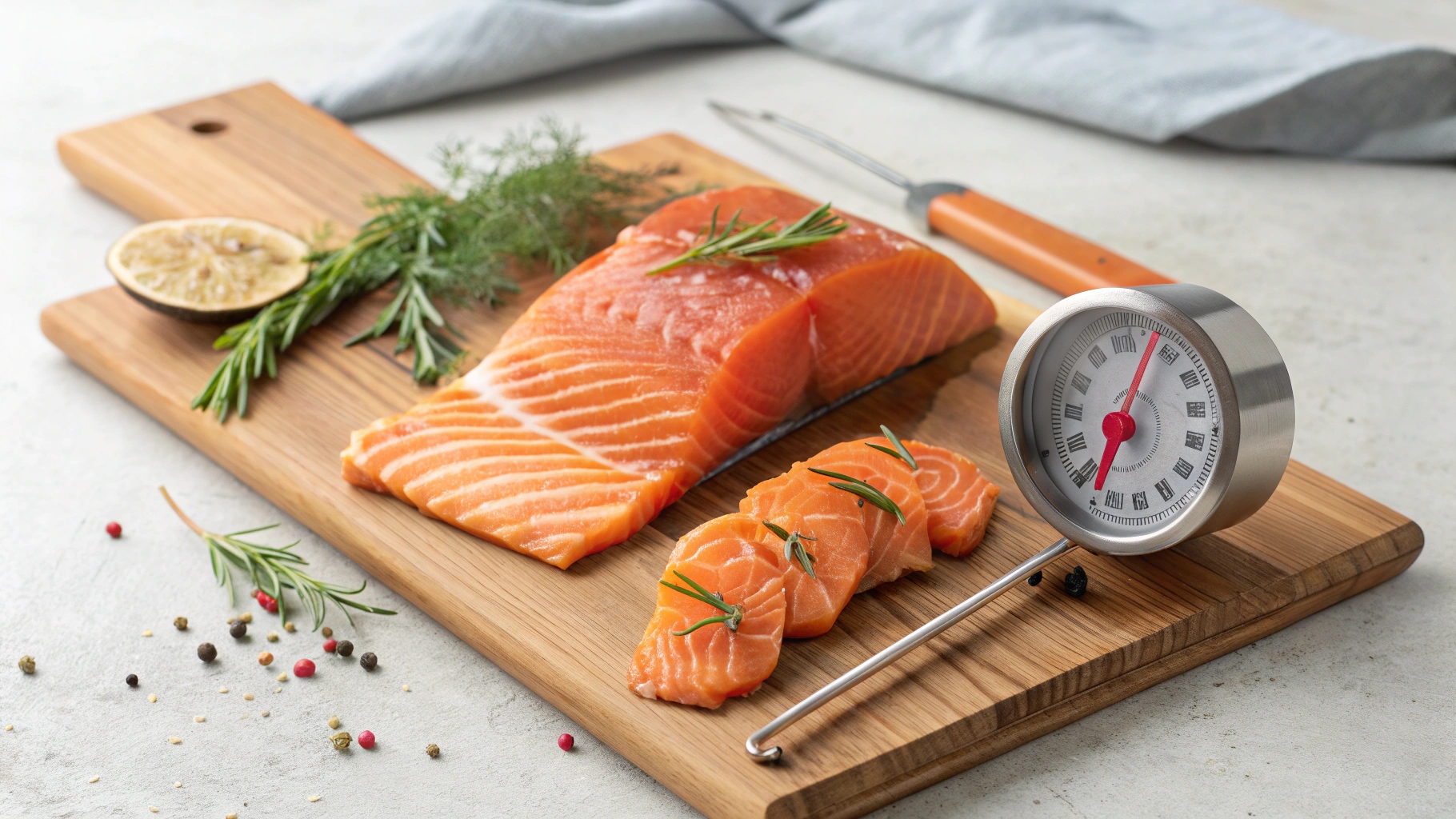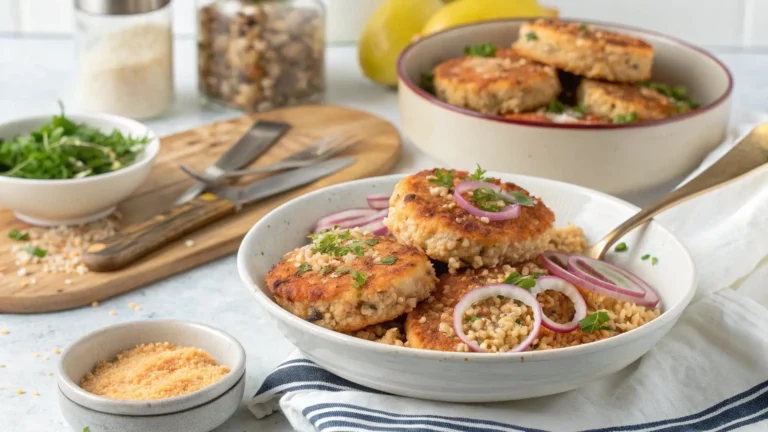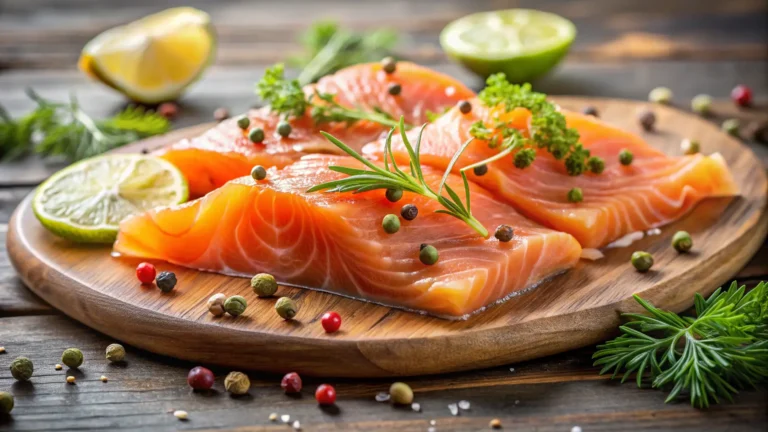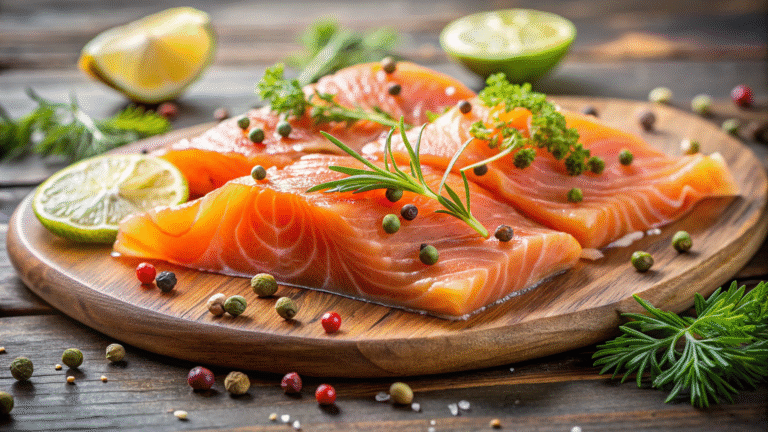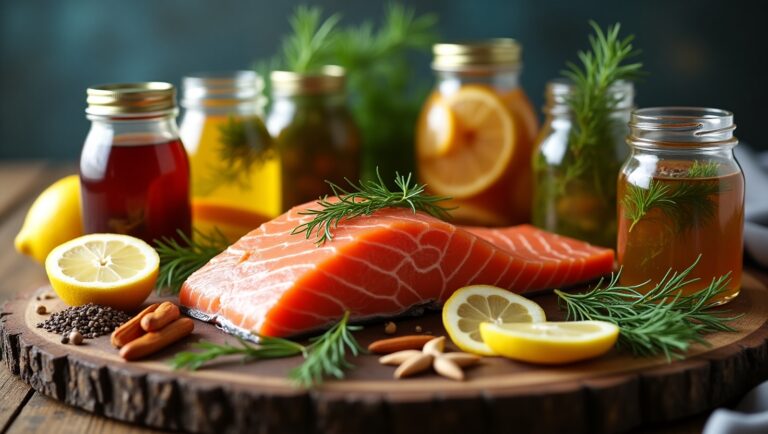Smoked Salmon Temperature: How to Master the 10°F Carryover Rule

The first time I watched my grandfather smoke salmon, I saw temperature as an art. He taught me in his rustic kitchen. Perfect smoked salmon temperature turns ordinary fish into a culinary masterpiece.
Knowing the right temperature for smoked salmon is key to making dishes like a pro. Whether you’re cooking at home or dreaming of being a chef, controlling temperature is crucial. This guide will show you four essential tips for delicious results every time.
Smoked salmon temperature affects texture, flavor, and safety. Learning these techniques will help you make salmon that’s tender, flavorful, and perfectly cooked.
Key Takeaways
- Temperature control is critical for perfect smoked salmon
- Different smoking methods require specific temperature ranges
- Food safety depends on reaching proper internal temperatures
- Proper resting time enhances salmon’s final texture
- Choosing the right smoker dramatically impacts flavor
Understanding Smoked Salmon Temperature
Smoked salmon turns regular fish into a gourmet delight. It’s all about the right temperature. Knowing the best smoking temperature can make your cooking better and your meals unforgettable.
What is Smoked Salmon?
Smoked salmon is fish that’s cured and smoked to boost its taste and keep it fresh. The smoking process needs careful temperature control. This affects both the safety and taste of the salmon. You have two main methods: hot smoking and cold smoking.
- Hot smoked salmon reaches higher temperatures (120-180°F)
- Cold smoked salmon maintains lower temperatures (below 90°F)
- Both methods create unique flavor profiles
The Importance of Temperature in Cooking
Temperature is key in making smoked salmon. It ensures the dish is safe and tastes great. The right temperature keeps the fish tender and full of flavor.
Temperature vs. Texture: What to Consider
Temperature affects the texture of smoked salmon. Lower temperatures make it silky and delicate. Higher temperatures make it firmer and more robust. Your chosen temperature will change how it tastes.
Professional chefs know that temperature is the secret ingredient in creating perfect smoked salmon.
Safe Cooking Temperatures for Smoked Salmon
When cooking smoked salmon, it’s important to watch the temperature closely. This ensures the salmon tastes great and is safe to eat. Knowing the right temperature is key to avoiding food poisoning and making a delicious dish.
USDA Recommendations for Salmon
The USDA has guidelines for cooking salmon safely. For smoked salmon, they suggest:
- Internal temperature should reach at least 145°F (63°C)
- Ensure fish is opaque and flakes easily with a fork
- Cook until the flesh is pearly and separates naturally
The Danger Zone: Understanding Food Safety
Bacteria grow fast between 40°F and 140°F, known as the “danger zone”. Keeping the smoked salmon at the right temperature stops harmful bacteria. Try to cook the salmon quickly to avoid this zone.
| Temperature Range | Food Safety Status |
|---|---|
| Below 40°F | Safe (Refrigeration) |
| 40°F – 140°F | Danger Zone (Bacterial Growth) |
| Above 145°F | Safe Cooking Temperature |
Tips for Measuring Temperature Accurately
Here are some tips for precise temperature control:
- Invest in a reliable digital meat thermometer
- Insert thermometer into the thickest part of the salmon
- Avoid touching bones or the cooking surface
- Wait a few seconds for an accurate reading
Pro tip: Clean your thermometer between readings to prevent cross-contamination and ensure accurate temperature measurements.
Cold Smoked vs. Hot Smoked Salmon
Exploring the best temperature for smoking salmon reveals the differences between cold and hot smoking. Each method changes the fish’s flavor, texture, and appeal.
Salmon smoking techniques vary in temperature and preparation. This creates different tastes and textures.
Temperature Differences Between Methods
Cold smoking uses lower temperatures, from 70-90°F. It keeps the salmon’s raw texture. Hot smoking heats up to 120-180°F. It cooks the fish while keeping it moist and tender.
- Cold Smoking: Temperatures below 90°F
- Hot Smoking: Temperatures between 120-180°F
- Curing process precedes both methods
Flavor and Texture Variations
The temperature greatly affects the salmon’s taste and texture. Cold-smoked salmon is silky and has mild flavors. Hot-smoked salmon is flaky and has a stronger taste.
| Smoking Method | Texture | Flavor Intensity |
|---|---|---|
| Cold Smoked | Silky, smooth | Mild, delicate |
| Hot Smoked | Flaky, firm | Rich, pronounced |
Best Uses for Each Type
Choosing between cold and hot smoked salmon depends on your dish. Cold-smoked salmon is great for appetizers and salads. Hot-smoked salmon is perfect for main courses and pasta.
- Cold Smoked: Appetizers, canapés, salads
- Hot Smoked: Main courses, pasta dishes, grain bowls
- Versatile for both gourmet and home cooking
Choosing the Right Smoker Temperature
Choosing the right temperature for smoked salmon is key to a great dish. Learning about temperature control can help you make perfect smoked salmon every time.
The temperature of your smoker is crucial for the perfect texture and taste of smoked salmon. The best temperature is between 150°F and 225°F, depending on your method.
Optimal Smoking Temperatures for Different Salmon Types
- Wild-caught salmon: 165°F – 175°F
- Farmed salmon: 175°F – 200°F
- Cold-smoked salmon: 90°F – 120°F
- Hot-smoked salmon: 200°F – 225°F
Factors Influencing Smoker Temperature
Several factors can affect your smoker’s temperature and the smoking process:
- Outdoor ambient temperature
- Wind conditions
- Smoker type and insulation
- Salmon thickness
Wood Types and Their Temperature Impacts
| Wood Type | Flavor Profile | Recommended Temperature |
|---|---|---|
| Alder | Mild, Sweet | 165°F – 175°F |
| Apple | Subtle, Fruity | 170°F – 185°F |
| Hickory | Strong, Robust | 180°F – 200°F |
| Maple | Sweet, Delicate | 160°F – 175°F |
Try different woods to find your favorite flavor while keeping the temperature right for smoked salmon. Your taste buds will love the journey!
Monitoring Internal Temperature for Perfection
Mastering the smoking salmon temperature guide needs precision and careful watching. Getting the internal temperature right is key for delicious, safe, and perfectly cooked salmon. It will impress your guests and satisfy your taste buds.
When smoking salmon, your meat thermometer is your most valuable tool. Accurate temperature measurement ensures the perfect balance of flavor, texture, and food safety.
Using a Meat Thermometer Effectively
To get an accurate reading when smoking salmon, follow these key steps:
- Insert the thermometer into the thickest part of the salmon fillet
- Avoid touching bones or the smoker rack
- Wait for the temperature to stabilize before reading
- Clean your thermometer between readings to prevent cross-contamination
Signs Your Salmon is Done
Beyond temperature, look for these visual and tactile indicators that your salmon is perfectly smoked:
- Color change: Salmon should turn from translucent to opaque
- Flake test: Gently press the fish – it should flake easily
- Internal temperature: Aim for 145°F for hot-smoked salmon
Adjusting Time Based on Thickness
Salmon thickness directly impacts smoking time and temperature. Thicker fillets need longer smoking at lower temperatures. This ensures even cooking without drying out the fish.
“Patience is key when smoking salmon – slow and steady wins the flavor race.”
Remember, a smoking salmon temperature guide is not a one-size-fits-all approach. Each piece of fish is unique. So, always be ready to make slight adjustments during the smoking process.
Resting Time and Its Effect on Temperature
Mastering smoked salmon is more than just cooking. The resting step is crucial for quality and taste. Knowing how temperature changes during resting is essential for a great dish.

Resting helps the salmon’s internal temperature stabilize. It also spreads moisture evenly. This is important for several reasons:
- Equalizes internal heat distribution
- Helps retain natural juices
- Improves overall texture and flavor
Why Salmon Needs Rest
After taking salmon out of the smoker, its temperature rises a bit. Resting prevents overcooking and makes it tender. Chefs suggest letting it rest for 5-10 minutes.
“Patience transforms good smoked salmon into an extraordinary dish.” – Culinary Expert
Optimal Resting Techniques
The best resting method depends on your preference. For warm salmon, cover it loosely with foil. For cold salmon, use a cooling rack to avoid moisture.
Temperature and Texture Transformation
Resting makes the salmon’s temperature stable. This relaxes proteins, making the texture smoother. A short wait can greatly improve your salmon’s quality.
Storing Smoked Salmon at the Right Temperature
Keeping smoked salmon fresh is all about the right storage. The temperature it’s smoked at is key to its taste and safety later on.
First, you need to know the temperature zones that keep salmon safe and tasty. These zones stop bacteria and keep the flavor from fading.
Ideal Storage Conditions for Freshness
Storing smoked salmon at the correct temperature is vital. Here are some tips:
- Refrigerate it right away after buying or making it
- Keep it at 32°F to 38°F
- Use containers that keep air out to stop moisture and smells
Refrigeration and Freezing Guidelines
Choose how you store it based on when you want to eat it:
| Storage Method | Duration | Recommended Temperature |
|---|---|---|
| Refrigerated (Unopened) | Up to 2 weeks | 32-38°F |
| Refrigerated (Opened) | 3-5 days | 32-38°F |
| Frozen | Up to 3 months | 0°F or below |
How Temperature Influences Shelf Life
Temperature is crucial for smoked salmon’s quality and safety. Consistent cold storage stops bacteria and keeps the salmon’s texture and taste. This is thanks to the smoking process.
Always look for spoilage signs, like color changes, bad smells, or sliminess. Do this, no matter how long it’s been stored.
Serving Temperature for Smoked Salmon
Serving smoked salmon at the right temperature can make a big difference. The best temperature is just the start. How you serve it is just as important. You want to bring out the flavors and keep the salmon’s texture just right.

Best Practices for Serving Smoked Salmon
Here are some tips for serving smoked salmon:
- Take salmon out of the fridge 15-20 minutes before you serve it
- Use a clean, sharp knife for slicing
- Put it on a chilled plate to keep the temperature right
- Slice it against the grain for tenderness
Room Temperature vs. Chilled
There’s a debate on whether to serve smoked salmon cold or at room temperature. Cold-smoked salmon is often best slightly chilled. But hot-smoked salmon might taste better at room temperature. Try both to see what you like best.
Garnishes That Enhance Temperature Experience
Use garnishes that match the temperature of your smoked salmon:
- Fresh dill adds a cool, crisp touch
- Capers bring a bright flavor
- Lemon wedges add a zesty contrast
- Cracked black pepper adds warmth
The right temperature for smoked salmon is just the start. Serving it well and with the right garnishes makes for a great meal.
Pairing Foods Based on Temperature
Smoked salmon’s cooking temperature is key to finding the best food and drink matches. Knowing how temperature affects taste can make your meals more enjoyable and memorable.
Choosing the right sides depends on whether your smoked salmon is warm or cold. Each temperature offers special chances for tasty pairings.
Complementary Sides for Warm Smoked Salmon
For warm smoked salmon, try these tasty sides:
- Roasted asparagus with lemon zest
- Creamy dill potato gratin
- Warm quinoa salad with herbs
- Caramelized fennel
Best Pairings for Cold Smoked Salmon
Cold smoked salmon calls for lighter, refreshing sides:
- Cucumber and cream cheese canapés
- Fresh herb salad
- Pickled red onions
- Avocado toast
Beverage Suggestions to Balance Temperature
Choosing the right drink can boost the smoked salmon’s flavor and temperature:
- Warm options: Herbal tea, light red wine
- Cold options: Crisp white wine, sparkling water with citrus
Troubleshooting Temperature Issues in Smoked Salmon
Getting the perfect temperature for smoked salmon can be tough, even for experts. It’s key to control the temperature to make delicious and safe salmon. Always be precise and watch the temperature closely.
Different smokers can cause temperature problems. Electric smokers are usually more steady, but charcoal and wood smokers need more attention. Always check the smoker’s temperature and use a meat thermometer for the salmon’s internal temperature.
It’s important to know how your smoker works. Some smokers get hotter at the bottom, while others heat unevenly. To fix this, rotate the salmon fillets halfway through and use foil to block heat.
To avoid mistakes, start with good-quality salmon. Remember, each piece might need a different temperature. Keep the smoker at 180-225°F for hot-smoked salmon. And don’t rush it. Being patient and careful is the key to great smoked salmon every time.

